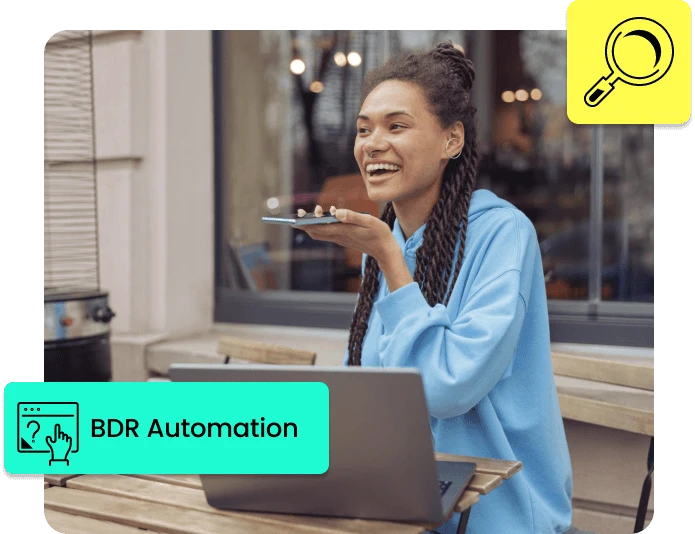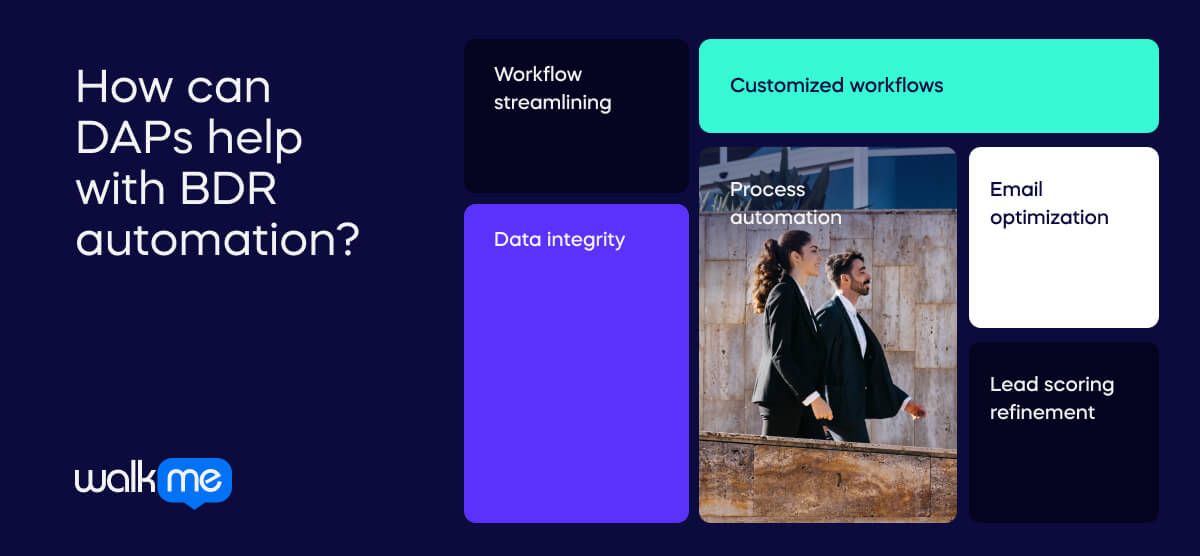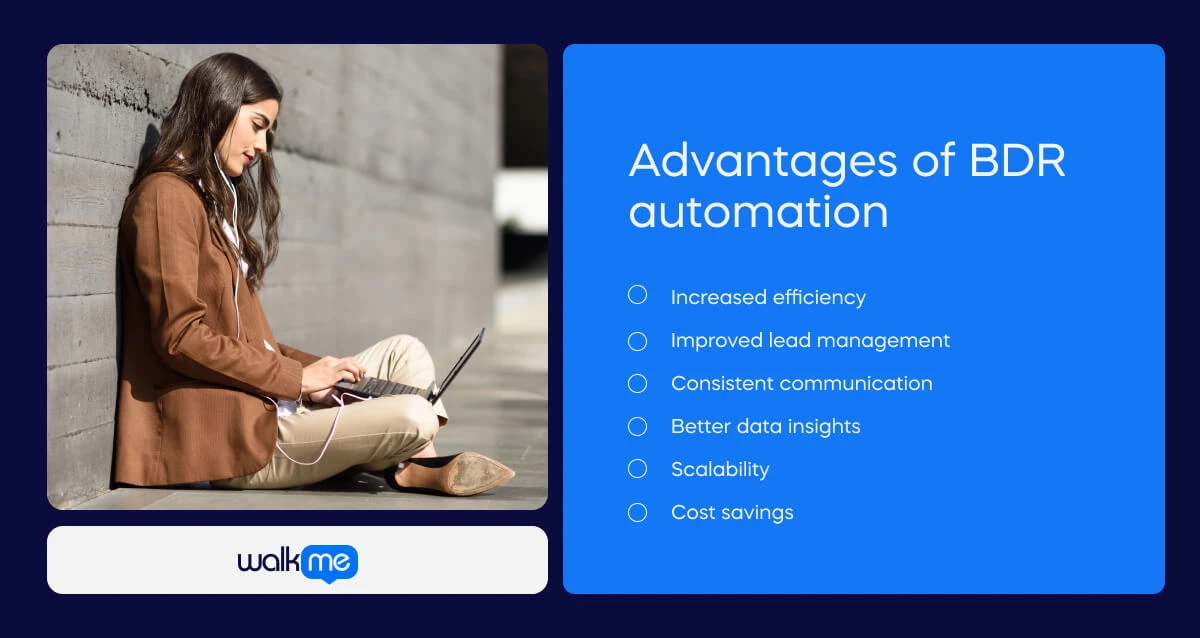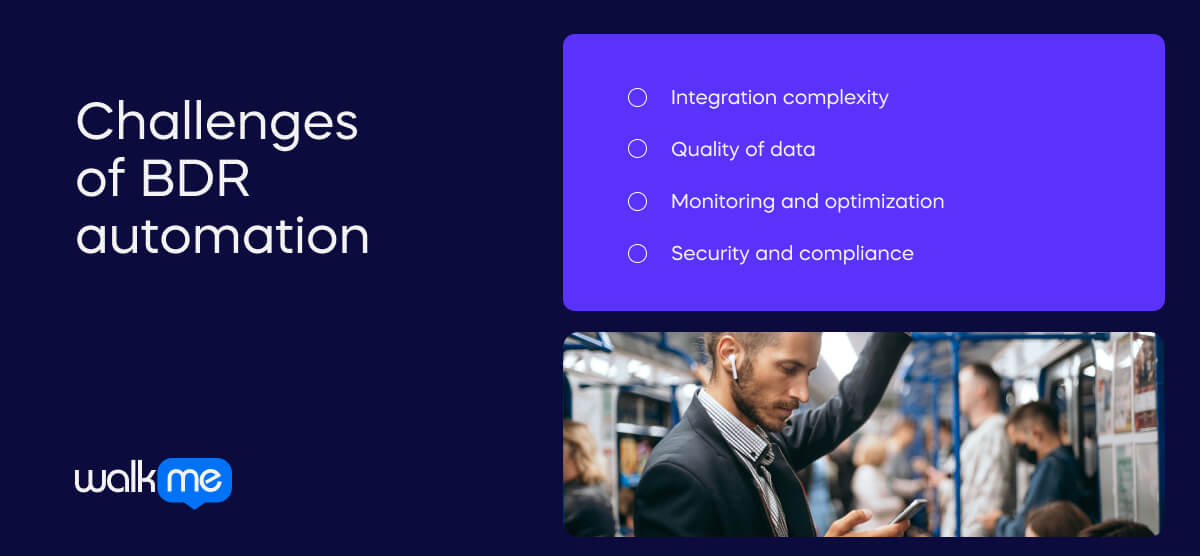BDR Automation

BDR automation is the process of automating various tasks and workflows. Business Development Representatives (BDRs) perform these processes. BDRs are responsible for prospecting, qualifying leads, and initiating contact with potential customers. Automation involves using software tools and technologies. They streamline tasks like lead research, email outreach, follow-up reminders, and data entry. By automating these tasks, BDRs can work on high-value tasks. These include building relationships with prospects and closing deals. They don’t need to spend excessive time on administrative tasks.
Business development representatives use many common automation tools in their processes. These include customer relationship management software and email automation platforms. Lead scoring systems and sales engagement platforms are also popular. These tools help BDRs to focus on their efforts. They are able to stay organized and become more efficient. Organizations which invest in BDR automation can help to keep their employees motivated. A report from 6sense reveals that the sense of support BDRs feel in the workplace has decreased from 76% in 2022, 64% in 2023, to 58% in 2024.
How can DAPs help with BDR automation?

A digital adoption platform (DAP) like WalkMe can help with BDR automation in several ways:
Workflow streamlining: Repetitive tasks can be automated by WalkMe. These include lead qualification, data entry, and follow-up reminders. As a result, BDRs can focus on more strategic activities.
Customized workflows: BDRs receive personalized in-app guidance based on their roles and responsibilities. WalkMe ensures that the right tasks are automated at the right time. This enhances efficiency and productivity.
Data integrity: WalkMe’s automation features help maintain accurate data. They reduce human error during data entry and updates.
Process automation: Specific steps within workflows can be automated. For example, WalkMe can automatically update records in a CRM after a successful call. It can also trigger follow-up tasks based on predefined rules.
Email optimization: Templates can be refined with WalkMe’s help. Furthermore, organizations can put A/B testing in place for specific subject lines. These features can help when BDRs face challenges with creating effective emails.
Lead scoring refinement: WalkMe can analyze successful conversions within BDR systems. It refines lead scoring by adjusting the criteria used.
Use cases for BDR automation
BDR automation in business
Here are three examples of business situations. They illustrate how BDR automation can manifest:
Lead qualification and segmentation
A software-as-a-service (SaaS) company receives a high volume of inbound leads through their website. BDR automation tools can automatically qualify leads. They make these selections based on predefined criteria. Examples include company size, industry, and budget. Leads can then be segmented into different categories (e.g., hot, warm, cold). Afterwards, they are routed to the appropriate BDRs or sales teams for follow-up.
Email outreach and follow-up
A marketing agency wants to nurture leads and prospects through personalized email campaigns. BDR automation platforms can automate email outreach. They send personalized messages to leads at predefined intervals. Automated follow-up sequences can be triggered based on recipient engagement. This ensures timely and persistent communication without manual intervention.
Pipeline management and forecasting
A manufacturing company needs to track and manage its sales pipeline. What’s more, the pipeline is across many regions and product lines. BDR automation tools integrated with CRM systems can automatically update the sales pipeline. It can achieve this in real-time. Automated alerts and notifications can be set up. These flag opportunities that require immediate attention or follow-up. Additionally, machine learning algorithms can analyze historical data. Using it, they forecast future sales trends and outcomes. This helps with obtaining accurate pipeline forecasting.
Success with BDR automation
Here’s how WalkMe helped a company to automate tasks and improve their CRM process:
GQR
The company uses a CRM called Bullhorn. WalkMe was able to assist in workflow streamlining. GQR was able to automate many ‘repetitive’ processes and save time thanks to WalkMe. GQR also allowed users to use the wealth of data available to them. By using Smart Walk-Thrus, workers could add in features they would not usually have used. They were able to access information that would usually have remained untouched.
BDR automation vs SDR automation
BDR (business development representative) automation and SDR (sales development representative) automation are different. They both aim to enhance sales processes. Yet, they focus on different stages of the sales cycle and have distinct objectives. Here’s a comparison:
| BDR automation | SDR automation | |
| Definition | The use of software tools and technologies to streamline and automate various tasks. Business development representatives (BDRs) perform these tasks in the sales process. | The use of software tools and technologies to streamline and automate various tasks. Sales development representatives (SDRs) perform these tasks in the sales process. |
| Employee responsibility | Qualifying leads, nurturing relationships with prospects, and converting qualified leads into sales opportunities. | Prospecting, generating leads, and initiating initial contact with potential customers. These people have not yet expressed interest in the company’s products or services. |
| Examples | Automating repetitive and time-consuming tasks. Examples include lead scoring, email outreach, follow-up, appointment scheduling, and pipeline management. | Automating tasks, like lead research and list building, can save time. It can also save time on email prospecting, cold calling, and initial lead qualification. |
| Benefit | By leveraging automation tools, BDRs can focus on high-value tasks. These include building relationships with prospects and closing deals. This improves outcomes and productivity in the sales organization. | SDRs benefit from using automation tools. They can increase the volume and quality of leads entering the sales pipeline. This drives better results and efficiency in the sales organization’s prospecting efforts. |
| Focus | Focuses on automating tasks related to qualifying and converting leads into opportunities. BDRs typically engage with leads that have already been identified as potential customers. Their aim is to move them further down the sales funnel. | Focuses on automating tasks related to prospecting and generating leads. SDRs are responsible for identifying and initiating contact with potential customers. These people have not yet expressed interest in the company’s products or services. |
| Tasks | Lead scoring, email outreach, lead nurturing, scheduling appointments, and managing the sales pipeline. | Lead research, list building, email prospecting, cold calling, and initial qualification of leads. |
| Objective | Accelerating the conversion of qualified leads into sales opportunitiesBuilding relationships with prospects Guiding them through the later stages of the sales process | Increasing the volume and quality of leads entering the sales pipelineIdentifying potential customers Initiating conversations to generate interest Qualifying leads for further engagement by BDRs or sales reps |
| Timing | Happens after leads have been identified and qualified by SDRs or marketing efforts. BDRs focus on further nurturing and converting these leads into opportunities. | Takes place during early stages of the sales process. At this point, SDRs are responsible for sourcing and qualifying leads. They then pass them on to BDRs or sales reps. |
Advantages of BDR automation

There are several advantages to implementing BDR automation in a sales organization:
Increased efficiency: BDR automation streamlines repetitive tasks. These could be lead scoring, email outreach, or follow-up. This allows BDRs to focus their time and energy on high-value activities. Examples include building relationships with prospects and closing deals.
Improved lead management: Automation tools can help BDRs to manage their leads. They can automatically score and segment them based on predefined criteria. This ensures that BDRs are focusing their efforts on the most promising opportunities.
Consistent communication: BDR automation ensures consistent and timely communication with prospects. Follow-up emails and reminders go out according to schedules. This helps keep prospects engaged throughout the sales process. It also increases the likelihood of conversion.
Better data insights: Automation tools provide valuable insights into prospect behavior and engagement. This allows BDRs to make more informed decisions and tailor their approach. This data-driven approach can lead to more effective sales strategies and improved results.
Scalability: BDR automation makes it easier to scale sales operations. By automating repetitive tasks, organizations can handle a larger volume of leads. This is achievable without increasing the size of their sales teams.
Cost savings: BDR automation reduces the need for manual intervention. It also frees up resources that can be allocated to other areas of the business. This can lead to cost savings in relation to both time and money.
Challenges of BDR automation

BDR automation offers numerous advantages. However, there are also several challenges associated with its implementation:
Integration complexity: Integrating BDR automation tools with existing systems can be complex. Ensuring seamless data flow and synchronization between different systems is crucial. Otherwise, automation initiatives may not be successful.
Quality of data: BDR automation relies on data quality for certain tasks. Examples include lead scoring and segmentation. Inaccurate or outdated data can lead to incorrect prioritization of leads. Plus, ineffective communication strategies could be built. Maintaining data hygiene and integrity is essential to maximize the benefits of automation.
Monitoring and optimization: Continuous monitoring and optimization are essential. This ensures that BDR automation processes remain effective over time. Ongoing analysis of performance metrics is key. So is identification of areas for improvement, and adjustment of automation strategies.
Security and compliance: Automation tools may handle sensitive customer data. As a result, security and compliance considerations are paramount. Ensuring data privacy is critical. So is keeping to regulations and having strong security. These steps lower the risk of data breaches and violations.
BDR automation: A win for all
BDR automation revolutionizes sales. It uses technology to make tasks faster, improve efficiency, and drive better results. DAPs are crucial for BDR automation. They provide tools and solutions to optimize workflows, train staff, and improve sales. In various business scenarios, BDR automation proves its value. It increases efficiency and improves lead management. It also ensures consistent communication and gives actionable data insights. Looking ahead, BDR automation has great promise. This is especially true with the continued advancement of DAPs. These platforms will be key. They will streamline BDR automation. They will do this by providing better tools for training. They will also provide tools for workflow and tracking performance. DAPs are evolving. They will let companies unlock more efficiencies and get better results in sales.